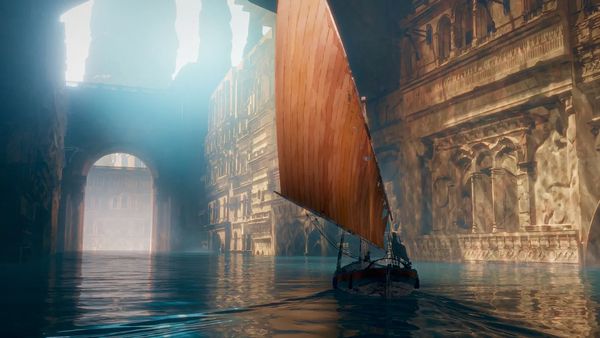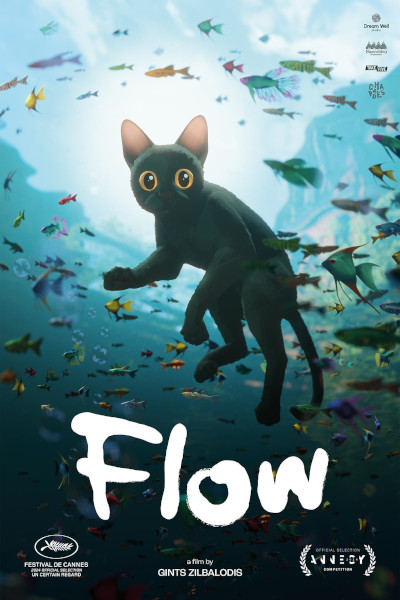Eye For Film >> Movies >> Flow (2024) Film Review
Flow
Reviewed by: Jennie Kermode

Small, slender and black as soot, with big yellow eyes, Cat lives a life that may at first seem familiar. Wandering around in woodland and meadows by day, gazing curiously at its reflection in a stream, it returns later in the day to its home, hopping up via the porch roof to a round attic window and thence to the soft bed inside – a bed perfectly positioned, it would seem, for catching sunbeams. But something is different here. Not far into Gints Zilbalodis’ beguiling animated film, we will explore other parts of the house. We will see the thick layers of dust, the half-finished wooden cat sculpture with abandoned tools nearby. There is no sign of any human; whoever adored this cat (and the artwork tells us that much) is long gone. That upstairs window is broken. A calamity is about to befall this place, and when it does, there will be no owner to come to the rescue.
Even if humanity succeeds in slowing the pact of climate change and sustaining its civilisation, it’s unlikely now that we can keep the average global temperature rise under 2°C, which means that parts of the planet are likely to become uninhabitable. What happens to those places then? Some other animals are more resilient, and may remain. Those plants that can endure the heat may flourish in our absence. Who will inherit this strange new world?

Screened as part of the Belfast Film Festival, Flow gives us a tour of the old and the new as Cat is forced to flee a terrifying flood. With none of the preconceived notions that hamper humans in such situations, Cat assesses every situation as it presents itself. A golden retriever is scary when part of a pack but, when they are alone together, is frightened and wants to make friends, with a loyalty that never falters. Large white birds are likewise scary in a group, but one of them steps up as a protector. Water is often dangerous but can be a source of food. As challenges present themselves, Cat discovers new powers within its own body, and learns to apply its native intelligence in new ways.
The bulk of the film takes place on a boat where a group of different animals seek refuge. Functioning as captain – though there is no dialogue and no real anthropomorphism – is a capybara, whose complete lack on interest in threat displays, and way of dealing with nervous strangers by flopping on it side, helps to keep the peace. There is also a ring-tailed lemur who refuses to be rescued without saving at least some of its collection of bottles, shiny objects and tools. Its fascination with a mirror, in particular, suggests that it is perpetually on the verge of making some kind of cognitive breakthrough. Zilbalodis keeps returning to this theme, but it’s a little more sophisticated than it might at first appear. This isn’t a Seventies science fiction style take in which one individual sees the light and embarks on the one true path to a glittering future. The weaknesses of that approach have already been exposed and Zilbalodis’ solution, when it comes, is something different.
The film is animated using incredibly detailed computer backdrops, with the animators’ direct focus being on the animals themselves. These are full of personality, but those personalities are of the sort that anyone who has spent time around the species in question might recognise. Cat’s viewpoint predominates, and Zilbalodis has an acute understanding of how the world looks from its point of view, of what catches its attention and how its body follows instinctively until experience and an awareness of danger gradually persuades it to think things through. This inside out approach sees movement stem from the animals’ interior selves, so that every small action tells us something about them. Their approach to interacting with unfamiliar types of animal fits with observation from life, mingling wariness, empathy and curiosity.
The title speaks not just to the flood – which looks stunning and often terrifying – but also to Cat’s journey and the feeling of being caught up in events, only gradually putting them together and identifying meaning. There is plenty there for astute observers, and much of it melancholic, in view of what it tells us about what has been lost, but there is also the sense of wonder that comes from seeing it through the eyes of individuals who understand none of that context, and whose excited discoveries and simple joys invite us to marvel at it too. One of the dangers of post-apocalyptic fiction is that it tempts us to despair, to imagine that nothing matters, but Zilbalodis has found a way to talk about the crisis we face in which everything matters, showing us a wild world which deserves to be loved and protected whether we get to live in it or not.
Without the need for speech or complex plotting, Flow is an engrossing adventure film which also has deeper currents. It’s a triumphant piece of filmmaking.
Reviewed on: 09 Nov 2024














